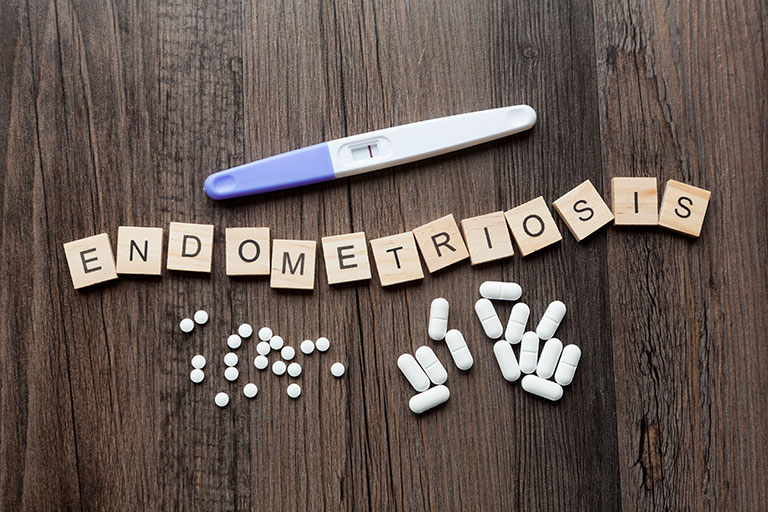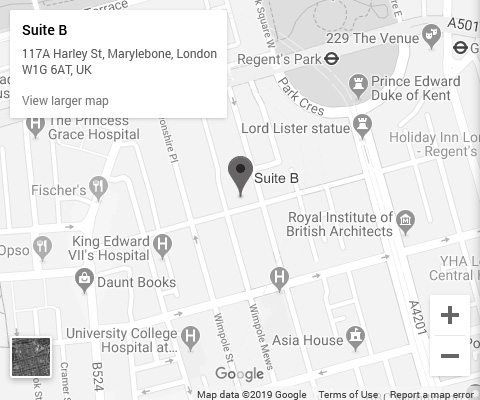Located at 20 Old Brompton Road – Just Steps from ![]() South Kensington Tube. Easy Access, Always.
South Kensington Tube. Easy Access, Always.
Endometriosis
Many women experience problems related to their menstrual flow and cycle — some of these issues can be painless and may go unnoticed, the same cannot be said for some others like Endometriosis.
Overview

Endometriosis is a disorder whereby the tissues similar to the endometrium – the womb lining begins to grow outside the uterus. The endometrium is a tissue that lines the inside of the uterus. This disorder is painful in most cases, however there are some cases where there is little or no pain.
During a woman's menstrual cycle, the endometrial tissue thickens, and if fertilisation does not occur between a sperm cell and a released egg, the tissues break down and bleed out as menstrual flow. With endometriosis, it is precisely the same. The endometrial tissues are the same; they thicken, break down and bleed. The problem arises when endometrial tissue breaks down and flow; they are trapped and have no way of leaving the body.
Endometriosis can involve the ovaries, the tissue lining of the pelvis, and even the fallopian tubes. Although it is possible, the endometrial tissue does not usually spread beyond the pelvic region. When the ovaries are involved, it causes cysts called endometriomas to develop. Even worse, surrounding tissues can become affected and irritated, causing scar tissues to develop and bind pelvic tissues and organs to each other, as a result of abnormal bands of fibrous tissues called adhesions.
Endometriosis can be painful, especially during menstrual periods. The pain can be severe or mild. However, with early detection, it can be treated effectively.
Causes of Endometriosis
Although the possible cause of Endometriosis is not exactly unproven, there are several indicated
factors which can cause endometriosis, they include:
- Transformation of Embryonic Cell Embryonic cells are cells in the earliest stages of development. Sometimes, hormones like estrogen can act on these cells, transforming them into endometrial-like cell implants. This mostly happens during puberty, as it is a time where the female hormones begin to manifest.
- Immune System Disorder When there is a problem with the body's immune system, it makes the immune system unable to recognise abnormal cells like the endometrial-like tissue growing outside the uterus. When the body fails to recognise them, it cannot be destroyed, and hence continues to grow.
- Retrograde Menstruation This is a complicated case where instead of the menstrual blood flowing out of the body through the cervix, the blood flows backwards, through the fallopian tubes, into the pelvic region. The menstrual blood contains endometrial cells, and as the blood flows back, the cells stick to the pelvic walls, and onto the surfaces of the pelvic organs. From here, they continue to thicken and bleed with each menstrual cycle.
- Implantation Of Surgical Scar Endometrial cells can also attach themselves to a surgical incision. Although this is typically after a surgery like a Caesarean section or a hysterectomy.
- Transformation of Peritoneal Cells Peritoneal cells are cells that line the inside of the abdomen. Experts propose that the peritoneal cells can be transformed into endometrial-like cells through the action of hormones or immune factors, in what is known as the "induction theory."
- Transport of Endometrial Cells Sometimes, endometrial cells can be transported to other parts of the body through the blood vessels or the lymphatic system — ultimately leading to endometriosis.
Associated Signs and Symptoms
The typical symptoms associated with endometriosis is pain in the pelvic region — it is sometimes associated with the menstrual flow. Menstrual cramps are common for most women during menstrual periods; however, with endometriosis, the pain is more severe than usual and can increase or grow over time.
Some other symptoms of endometriosis include;
- Bleeding Endometriosis brings with it, occasional heavy menstrual periods, which are more than your normal flow. Sometimes, you may experience intermenstrual bleeding — this is bleeding that occurs between periods.
- Dysmenorrhea This refers to pain and cramps days before the menstrual period and can even extend days into the period. It may be accompanied by abdominal pain or lower backache.
- Painful Intercourse Pain during or after sexual intercourse regular with endometriosis.
- Infertility For women who are seeking treatment for infertility, endometriosis is often first diagnosed as a possible cause.
- Painful Bowels and Urination This symptom is felt most when you are on your period. Pain is associated during bowel movements and urination.
There are other symptoms one can experience with endometriosis. Although they are usually noticed when you are on your menstrual period. These symptoms include:
- Constipation
- Fatigue
- Bloated feeling
- Diarrhoea
- Nausea
Note that the degree of pain felt is not an indicator of the severity of the condition. This means that there can be cases where one is experiencing severe pain when they only have mild endometriosis, and there could be little or no pain in advanced endometriosis.
Sometimes, endometriosis can be mistaken for other conditions of the pelvic region like pelvic inflammatory disease (PID) or ovarian cysts, due to the pain it causes. Also, it can equally be mistaken for Irritable Bowel Syndrome (IBS), due to the diarrhoea, abdominal cramping or constipation. Sometimes, the diagnosis of endometriosis can become complicated when IBS accompanies it.
Women’s Health is Our Passion
Live life to the fullest with our range of Consultant-led gynaecological services.
BOOK ONLINE NOWWho Is at Risk?
Some factors place people at risk of having endometriosis. People who are at a higher risk of having endometriosis include women who;
- Have a low body mass index
- Have a short menstrual cycle, usually less than 27 days
- Go through menopause at an older age
- Started menstruating at an early age
- Have reproductive tract abnormalities
- Have never given birth
- Have one or more close relatives with endometriosis
- Have a higher level of oestrogen and women who are exposed to more oestrogen in their bodies
- Have menstrual periods that last more than a week
- Have any medical condition that obstructs normal menstrual body flow
Endometriosis does not set in suddenly; it takes time and begins to develop several years after the first menstrual period known as menarche. The symptoms may improve with pregnancy or may disappear on its own when menopause sets in.
Possible Complications
Two serious complications can arise as a result of endometriosis, which includes:
- Cancer Endometriosis does not increase the rate of ovarian cancer in women, although some experts believe it can. The overall ovarian cancer is relatively low in women. However, endometriosis can increase the risk of another type of cancer; the endometriosis-associated adenocarcinoma for women, later in life.
- Infertility Impaired infertility is the major complication associated with endometriosis. It has been verified that about 1 in every three women, or 1 in every two women who have endometriosis may have difficulties getting pregnant.
Endometriosis can affect pregnancy by blocking the tubes and preventing fertilisation between the egg and the sperm cells. It can affect fertility by damaging reproductive cells ultimately.
However, people with mild endometriosis can still get pregnant. Although they will be advised by the doctor not to delay with having children as the disorder can get worse over time.
If any of these symptoms of endometriosis is noticeable, you should seek medical help immediately — early diagnosis will aid significantly with efficient treatment.
Place a call to us on 02071835411 today or visit us at South Kensington, London
 Click To View Full Map
Click To View Full Map
Contact Info
Phone: 020 71835411
Email: info@gynaeuk.com
Address:
20 Old Brompton Road, South Kensington, London SW7 3DL
Opening Hours
| Day | Opening Hours |
|---|---|
| Monday | 9am to 6pm |
| Tuesday | 9am to 8pm |
| Wednesday | 9am to 6pm |
| Thursday | 9am to 8pm |
| Friday | 8am to 5pm |
| Saturday | 10am to 4pm |
| Sunday | Closed |

